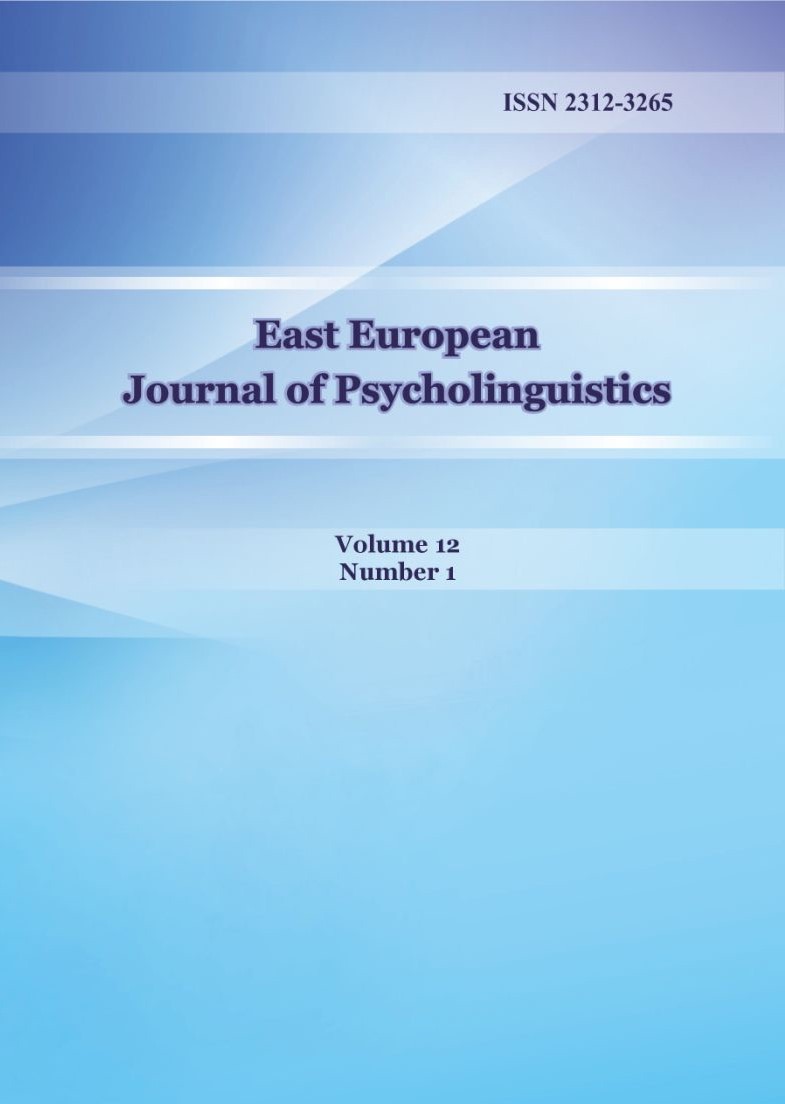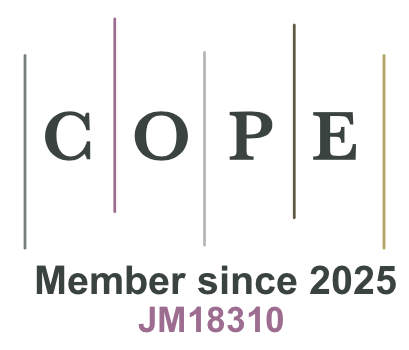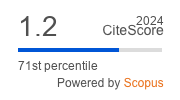Утворення серійних прикметників у йорданських студентів, які вивчають англійську як іноземну
DOI:
https://doi.org/10.29038/eejpl.2025.12.1.alnКлючові слова:
порядок прикметників, прикметники у функції означення, йорданські студенти, які вивчають англійську як іноземну мову, прикметник-станівникАнотація
Це дослідження присвячено вивченню питання вживання серійних прикметників у мовленні йорданських студентів, які вивчають англійську мову як іноземну, з особливим акцентом на тому, як кількість і синтаксична позиція прикметників впливають на їхню послідовність. На основі універсальної моделі серійності Скотта (2002) дослідження вивчає дотримання студентами правил послідовності прикметників. Дані було зібрано від 30 студентів університету за допомогою двох тестів, що оцінювали атрибутивні та предикативні прикметники. Результати засвідчили, що студенти демонстрували точніші відповіді під час побудови речень з двома прикметниками, ніж з трьома або чотирма. Крім того, результати були кращими з прикметниками у функції означення, аніж із предикативними прикметниками. Одержані дані ставлять під сумнів поняття універсальної ієрархії в порядку прикметників, підкреслюючи роль когнітивних обмежень у формуванні студентських рішень. Автори пропонують змінити педагогічні підходи, щоб надати пріоритет ефективній комунікації над суворим дотриманням синтаксичних ієрархій. Крім того, викладачам мов рекомендують розробляти завдання, спрямовані на поступове оволодіння синтаксичною складністю та контекстуалізовану практику вживання прикметників.
Декларація щодо конфлікту інтересів
Автори повідомили про відсутність потенційного конфлікту інтересів.
Завантажити
Посилання
Albaqami, R. (2023). Mastering English Multiple Adjectives Ordering among Early versus Late Second Language Speakers: Evidence from Arabic-English Bilinguals. International Journal of Language and Literary Studies, 5(2), 343-367. https://doi.org/10.36892/ijlls.v5i2.1357
Algeo, J. (1987). A Comprehensive Grammar of the English Language. By Randolph Quirk, Sidney Greenbaum, Geoffrey Leech, and Jan Svartvik. London: Longman. 1985. x+ 1779. Journal of English Linguistics, 20(1), 122-136. https://doi.org/10.1177/007542428702000108
Alghannam, M. S. M. (2024). Factors affecting difficulty of English pre-nominal adjective order for Saudi learners. Forum for Linguistic Studies, 6(5), 925–942. https://doi.org/10.30564/fls.v6i5.6825
Alghazo, S., & Jarrah, M. (2023). No Adjective Ordering Preferences in Jordanian Arabic Grammar. Journal of Psycholinguistic Research, 52(5), 1633-1667. https://doi.org/10.1007/s10936-023-09965-0
Almalki, H. (2024). An Assessment of Acquiring English Attributive Adjective Order by Saudi University Freshmen and Senior EFL Students. رسالة المشرق (Al-Mashriq Journal), 39(4), 3-23. https://doi.org/10.21608/rmshreq.2024.403272
Alotaibi, M. A., & Alotaibi, A. M. (2017). On the acquisition of the prenominal adjective order by Kuwaiti EFL learners. Advances in language and literary studies, 8(1), 1-8. https://doi.org/10.7575/AIAC.ALLS.V.8N.1P.1
Alrashed, M. A. (2024). The Impact of L1 Transfer on Learning English Adjective Order by Saudi EFL Learners. Journal of Language Teaching and Research, 15(6), 1845-1853. https://doi.org/10.17507/jltr.1506.10
Al-Saidat, E. M., Al-Shalabi, F. A., & Amer, F. H. (2024). Acquisition of prenominal adjective order by Jordanian EFL learners. Jurnal Cakrawala Pendidikan, 43(3), 534–545. https://doi.org/10.21831/cp.v43i3.76330
Amer, W. M. (2012). An investigation into the differences between English and Arabic position and order of adjectives: A contrastive study with pedagogical implications. Albahr Al-Ahmer University Journal, 5, 205-229.
Amusan, K. V. (2025). The acquisitional challenges of adjective order among non-native learners of English. International Journal of Research Studies in Education, 14(1), 63-74. https://doi.org/10.5861/ijrse.2025.25002.
Baddeley, A. (2007). Working memory, thought, and action. Oxford Academic. https://doi.org/10.1093/acprof:oso/9780198528012.001.0001
Baddeley, A. D., & Hitch, G. (1974). Working memory. In G. A. Bower (Ed.), Psychology of learning and motivation, Vol. 8, (pp. 47–89). Academic Press. https://doi.org/10.1016/S0079-7421(08)60452-1
Bošković, Ž. (2005). On the locality of left branch extraction and the structure of NP. Studia Linguistica, 59(1), 1–45. https://doi.org/10.1111/j.1467-9582.2005.00118.x
Bouchard, D. (2002). Adjectives, number, and interfaces: Why languages vary. Elsevier.
Chomsky, N. (2005). Three factors in language design. Linguistic Inquiry, 36(1), 1–22.
Chomsky, N. (2011). Language and other cognitive systems. What is special about language? Language Learning and Development, 7(4), 263–278.
Cinque, G. (1994). On the evidence for partial N-movement in the romance DP. In R. S. Kayne, G. Cinque, J. Koster, J. Y. Pollock, L. Rizzi, & R. Zanuttini (Eds.), Paths towards universal grammar: Studies in honor of Richard S. Kayne. (pp. 85–110). Georgetown University Press. https://doi.org/10.1017/CBO9780511554261.011
Cinque, G. (2010). The syntax of adjectives: A comparative study. MIT Press. https://doi.org/10.7551/mitpress/9780262014168.001.0001
Gibson, E. (1998). Linguistic complexity: Locality of syntactic dependencies. Cognition, 68(1), 1-76. https://doi.org/10.1016/s0010-0277(98)00034-1
Gibson, E. (2000). The dependency locality theory: A distance-based theory of linguistic complexity. In A. Marantz, Y. Miyashita, & W. O'Neil (Eds.), Image, language, brain: Papers from the first mind articulation project symposium (pp. 94–126). The MIT Press.
Hawkins, J. A. (2004). Efficiency and complexity in grammars. Oxford University Press.
Leivada, E. (2022). Determining the cognitive biases behind a viral linguistic universal: the order of multiple adjectives. Humanities and Social Sciences Communications, 9, 436. https://doi.org/10.1057/s41599-022-01440-w
O’Grady, W. (2021). The natural syntax of local coreference. Frontiers in Psychology, 12, 660296. https://doi.org/10.3389/fpsyg.2021.660296
Scott, G. J. (2002). Stacked adjectival modification. Functional Structure in DP and IP: The Cartography of Syntactic Structures, 1, 91-122. https://doi.org/10.1073/pnas.1903403116
Swan, M. (2005). Practical English Usage 3rd edition. Oxford University Press.
Appendix A
Attributive Adjectives
Test 1
The following sentences contain multiple adjectives. Please read each sentence carefully and decide whether the adjectives (provided in brackets) are correctly ordered. If they are not, reorder them to create correct sentences.
1. I bought a (long/Indian) shirt.
The correct answer: I bought a ___________________________________ shirt.
2. I saw a (big/beautiful) house.
The correct answer: I saw a ___________________________________ house.
3. I found a (red/small) car.
The correct answer: I found a ___________________________________ car.
4. I bought a (wide/wooden) table.
The correct answer: I bought a __________________________________ table.
5. I visited a (wide/deep) river.
The correct answer: I visited a ___________________________________ river.
6. I bought a (small/wooden/ brown) table.
The correct answer: I bought a ____________________________________ table.
7. I bought a (fast/Chinese/beautiful) car.
The correct answer: I bought a ___________________________________ car.
8. I found a (big/glass/old) vase.
The correct answer: I found a ___________________________________ vase.
9. I bought a (blue/new/square) clock.
The correct answer: I bought a ___________________________________ clock.
10. I visited a (gray/Roman/stone) building.
The correct answer: I visited a ___________________________________ building.
11. I bought a (beautiful/wide/fastJapanese) car.
The correct answer: I bought a ___________________________________ car.
12. I bought (red/Turkish/big/cotton) shirts.
The correct answer: I bought ___________________________________ shirts.
13. I found a (round/wooden/small/blue) box.
The correct answer: I found a ___________________________________ box.
14. I ate a (delicious/small/fresh/Turkish) cake.
The correct answer: I ate a ___________________________________ cake.
15. I saw a cute/old/white/small) dog.
The correct answer: I saw a ___________________________________ dog.
Appendix B
Predicative Adjectives
Test 2
The following sentences contain multiple adjectives. Please read each sentence carefully and decide whether the adjectives (provided in brackets) are correctly ordered. If they are not, reorder them to create correct sentences.
1. The explanation was (long/useful).
The correct answer: The explanation was ___________________________________
2. The house was (high/nice).
The correct answer: The house was ___________________________________
3. The car is (red/metal).
The correct answer: The car is ___________________________________
4. The sea is (deep/big).
The correct answer: The sea is ___________________________________
5. The man was (brown/old).
The correct answer: The man was ___________________________________
6. The house was (warm/big/high).
The correct answer: The house was __________________________________
7. The tower was (high/white/old).
The correct answer: The tower was _____________________________________
8. The sea is (blue/wide/deep).
The correct answer: The sea is ___________________________________
9. The explanation is (useful/fast/long).
The correct answer: The explanation was ___________________________________
10. The table is (wooden/rectangular/Italian).
The correct answer: The table is ___________________________________
11. The house is (large/white/old/rectangular).
The correct answer: The house is ___________________________________
12. The car is (Chinese/red/fast/new).
The correct answer: The car is ___________________________________
13. The mountain is (tall/cold/ancient/rocky).
The correct answer: The mountain is ___________________________________
14. The dog was (friendly/black/old/small).
The correct answer: The dog was _____________________________________
15. The cake was (delicious/chocolate/round/fresh).
The correct answer: The cake was ___________________________________
Завантаження
Опубліковано
Номер
Розділ
Ліцензія
Авторське право (c) 2025 Ayah Alnajjar, Abdel Rahman Altakhaineh

Ця робота ліцензується відповідно до ліцензії Creative Commons Attribution 4.0 International License.








 Creative Commons «Attribution» 4.0
Creative Commons «Attribution» 4.0